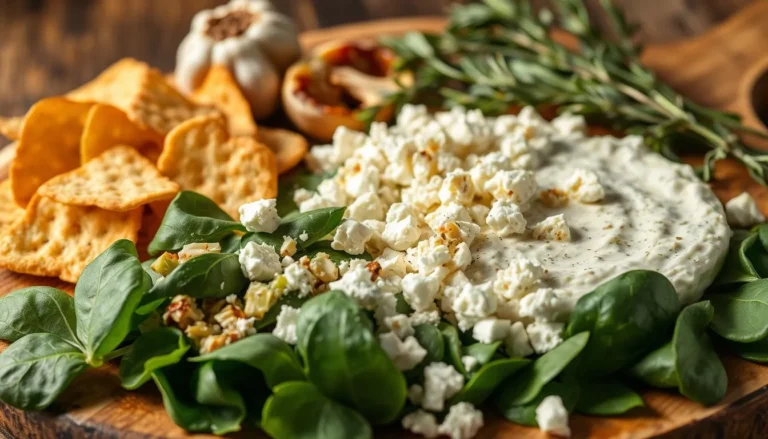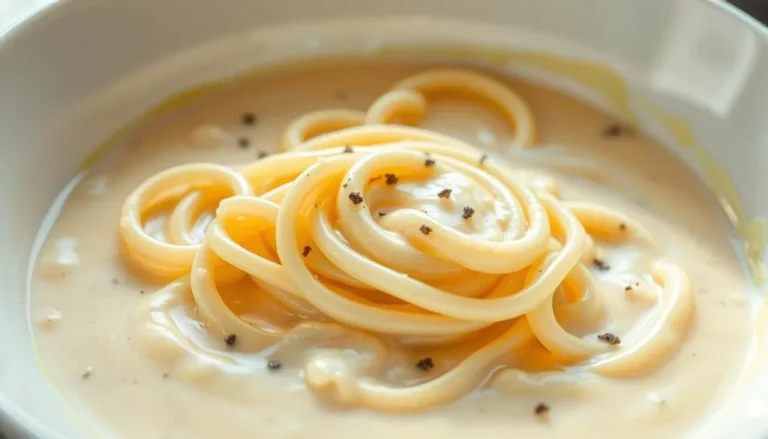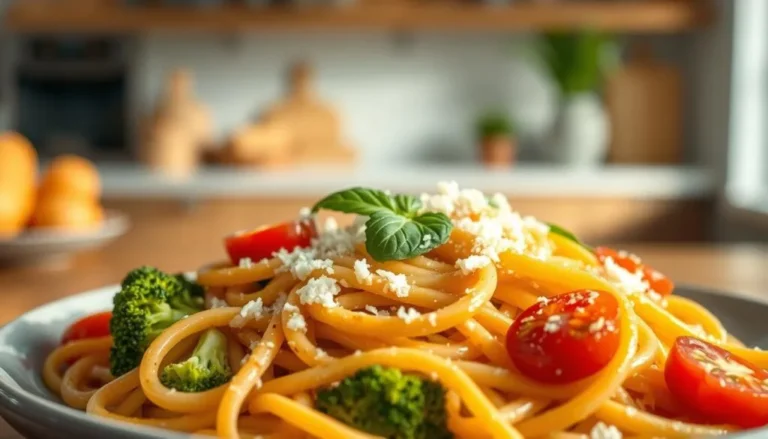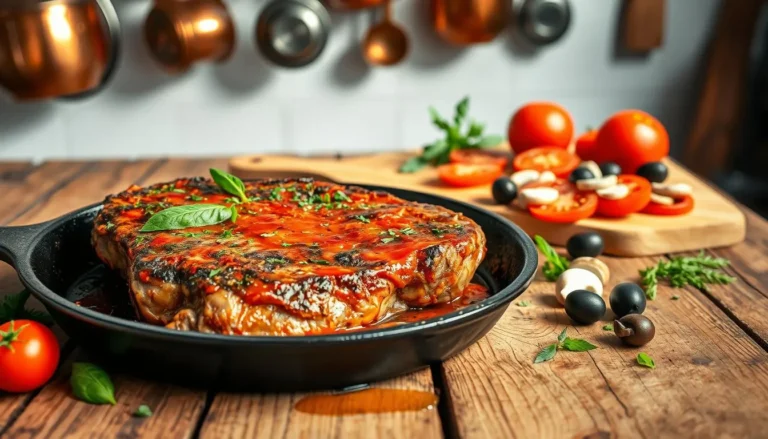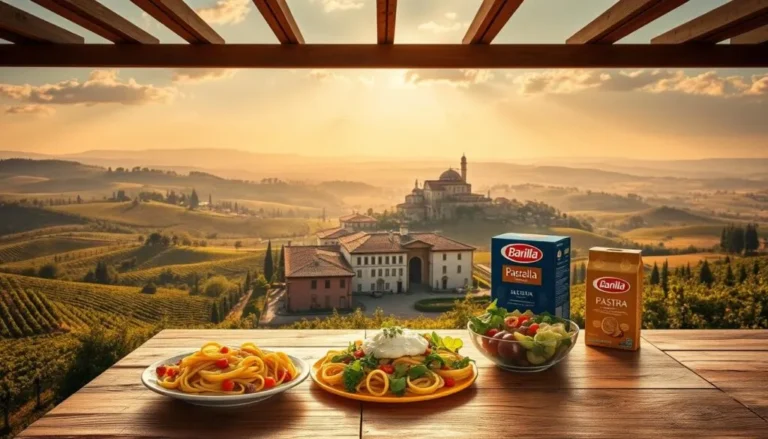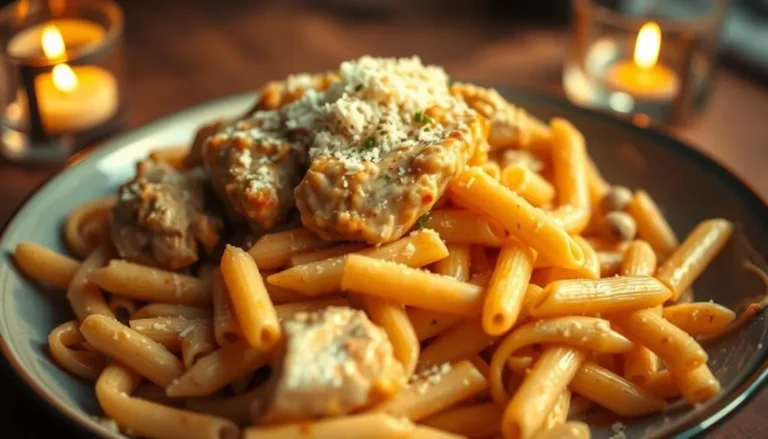How to Cook Perfect Corkscrew Pasta in 20 Minutes
Table of Contents
Looking for a tasty meal that’s quick to make? Corkscrew pasta, or fusilli, is your go-to. These spirals are more than just pasta. They’re a blank canvas for flavors, ready in just 20 minutes.
Picture turning simple ingredients into a dish that wows everyone. With corkscrew pasta, you can make meals that look like they came from a fancy restaurant. Impress your loved ones with ease.
Key Takeaways
- Corkscrew pasta takes only 20 minutes to cook perfectly
- Fusilli’s unique shape helps trap sauces beautifully
- Versatile for hot and cold dishes
- Easy to prepare for quick weeknight meals
- Ideal for both beginner and experienced cooks
Essential Kitchen Tools and Ingredients for Corkscrew Pasta
Making delicious helical pasta needs the right tools and ingredients. The right kitchen setup is key to making perfect twists. These twists are essential for holding sauce well. Let’s look at the tools and ingredients you need for great curly noodles.
Required Cookware and Utensils
To cook corkscrew pasta well, you’ll need some important kitchen tools:
- Large pot (at least 6-8 quarts)
- Sturdy colander for draining
- Long-handled wooden spoon
- Kitchen scale for measuring pasta
- Sharp kitchen knife
![Corkscrew Pasta]](https://www.recipesadam.com/wp-content/uploads/2025/03/Corkscrew-Pasta-4.webp)
Quality Ingredients Selection
Choosing high-quality ingredients makes your pasta dish stand out. Here are the key ingredients:
| Ingredient | Recommended Quantity | Purpose |
|---|---|---|
| Pasta Flour | 200 grams | Base for homemade pasta |
| Olive Oil | 2-3 tablespoons | Enhancing flavor |
| Fresh Eggs | 2-3 large eggs | Binding pasta dough |
Salt and Seasoning Options
Seasoning your helical pasta right makes it go from good to great. Sea salt is best for pasta water, using 1-2 tablespoons per pound. Here are some seasoning tips:
- Add salt to boiling water before inserting pasta
- Use kosher or sea salt for best flavor
- Taste water – it should be slightly salty
Pro tip: Your pasta water should taste like the sea – well-seasoned but not overwhelming.
Understanding Different Types of Corkscrew Pasta
![Corkscrew Pasta]](https://www.recipesadam.com/wp-content/uploads/2025/03/Corkscrew-Pasta-2.webp)
Twisted pasta shapes add excitement to cooking. Corkscrew-shaped pastas have unique textures and hold sauces well. They are loved by both home cooks and chefs.
Let’s look at the top corkscrew pasta types:
- Rotini: The classic corkscrew pasta with tight spirals perfect for catching sauces
- Fusilli: A versatile twisted pasta that works brilliantly in both hot and cold dishes
- Cavatappi: A tubular corkscrew shape ideal for baked pasta dishes
- Gemelli: Two intertwined strands creating a delightful twisted appearance
Each twisted pasta shape adds something unique to your meal. Cavatappi, for example, has lots of nooks and crannies for sauces. Its ridged surface makes every bite full of flavor.
Think about the dish you’re making when choosing corkscrew pasta. Rotini is great in pasta salads, and Fusilli catches small bits of meat and veggies well. These pastas are usually about 1/4 inch thick, offering a nice texture.
Pro tip: Try different corkscrew pasta types to find the best match for your favorite dishes!
Proper Water-to-Pasta Ratio and Salt Measurements
Cooking perfect spiral-shaped pasta varieties needs careful water and salt amounts. Knowing the right amounts can make your pasta truly special.
![Corkscrew Pasta]](https://www.recipesadam.com/wp-content/uploads/2025/03/Corkscrew-Pasta-3.webp)
Water Temperature Guidelines
Use a big pot for your pasta. You need 6 quarts of water for every 1 pound of pasta. This space helps pasta cook evenly and prevents it from sticking.
- Start with cold water from the tap
- Bring water to a boil before adding pasta
- Keep the heat high while cooking
Salt Proportions for Perfect Taste
Salting your pasta water is key for flavor. Chefs suggest using 2 to 3 tablespoons of kosher salt for 6 quarts of water. The salt should be slightly salty but not too much.
Pasta Quantity Calculations
Figuring out how much pasta you need depends on your serving size. A standard serving is 3 to 4 ounces of dried pasta per person for a main dish.
- Measure 3-4 ounces per person
- Adjust amounts for more guests
- Think about side dishes when planning portions
Pro tip: Always taste your pasta water before adding the spiral-shaped pasta to ensure proper seasoning!
Step-by-Step Guide to Cooking Corkscrew Pasta
Learning to cook corkscrew pasta, or fusilli, is simple. These spirals are great for holding sauces, making meals tasty in minutes. Here’s how to cook your pasta just right.
- Prepare your cooking equipment:
- Large pot
- Colander
- Wooden spoon or pasta fork
- Water preparation:
- Use 4-6 quarts of water per pound of corkscrew pasta
- Add 1 tablespoon of sea salt
- Bring water to a rolling boil
- Cooking process:
- Gently add spirals to boiling water
- Stir immediately to prevent sticking
- Cook for 9-11 minutes for dry pasta
- Cook for 6-8 minutes for fresh pasta
The secret to great corkscrew pasta is watching the cooking time. These spirals are versatile and hold sauce well. Pro tip: Always taste test a piece of pasta to check for the ideal al dente texture.
Remember, different brands might cook slightly differently. Always check the package and start testing your pasta a minute or two before the recommended time. You want that perfect al dente texture, tender yet firm.
Cooking pasta is an art that combines precision and intuition. Trust your instincts and don’t be afraid to experiment!
Achieving the Perfect Al Dente Texture
Cooking helical pasta to perfection is an art. You want it tender but still firm in the middle. Al dente pasta makes your dish special.
To get the perfect texture, follow some key steps. Your corkscrew pasta should feel slightly firm when you bite. This adds a nice chewiness to your meal.
Testing for Doneness
It’s important to know when your pasta is just right. Here are some ways to check:
- Start testing 2-3 minutes before the package’s recommended cooking time
- Remove a single piece of pasta and bite into it carefully
- Check for a slight firmness in the center
- The pasta should have a uniform color but not appear chalky
Common Cooking Mistakes to Avoid
Staying away from common mistakes is key. Here are some to watch out for:
- Overcrowding the pot, which prevents even cooking
- Failing to stir occasionally, causing pasta to stick
- Not using enough water for proper pasta movement
- Ignoring the recommended cooking times
Pro tip: Always save a bit of pasta water. It helps with sauce consistency and coats your twists perfectly.
Quick and Fresh Corkscrew Pasta Recipes
Curly noodles are great for making tasty meals in just 20 minutes. They hold onto sauces and ingredients better than other pasta. This makes them perfect for quick, flavorful dishes that everyone will love.
Here are some tasty corkscrew pasta recipes that show how versatile these noodles are:
Summer Corkscrew Pasta Salad
- Prep time: 20 minutes
- Servings: 6
- Nutritional highlights:
- Calories per serving: 520
- Protein: 10g
- Total fat: 22g
This dish is a refreshing mix of summer flavors with your favorite twisted pasta. Fresh ingredients make for a memorable meal.
Ingredients:
- 1 pound fusilli pasta
- 3 cups cherry tomatoes
- 1 cucumber, diced
- 1 bell pepper, chopped
- ½ cup black olives
- 8 oz feta cheese
- Lemon-garlic dressing
Quick Preparation Method:
- Cook curly noodles until al dente
- Chop fresh vegetables
- Mix pasta with vegetables and cheese
- Drizzle with lemon-garlic dressing
- Serve chilled or at room temperature
Pro tip: These twisted pasta shapes are great for holding onto dressings and capturing every bit of flavor. They’re perfect for both cold summer salads and warm pasta dishes.
Tip: Always reserve ½ cup of pasta water to help your sauce cling perfectly to these delightful curly noodles!
Tips for Storing and Reheating Leftover Pasta
Keeping your corkscrew-shaped pastas fresh is key. Whether it’s for a family dinner or leftovers, knowing how to store and reheat is crucial. It helps keep the pasta’s taste and texture just right.
Refrigeration Storage Guidelines
Here are some important tips for storing cooked pasta:
- Cool pasta to room temperature within 2 hours of cooking
- Use airtight containers to prevent moisture loss
- Refrigerate for maximum 3-5 days
- Separate pasta from sauce if possible to maintain best texture
Freezing Techniques
Freezing your corkscrew-shaped pastas can make them last longer. It also makes for easy meals:
- Store in freezer-safe containers or heavy-duty freezer bags
- Remove as much air as possible to prevent freezer burn
- Freeze for up to 2 months
- Label containers with date of storage
Safe Reheating Methods
Here’s how to make your spiral-shaped pasta taste like new again:
- Microwave: Heat in 30-second intervals, stirring between each
- Stovetop: Add a splash of water or olive oil to prevent drying
- Oven: Cover with foil to retain moisture
- Avoid overheating to maintain pasta’s original texture
Pro tip: Always check for signs of spoilage like unusual smell or slimy texture before consuming stored pasta.
Nutritional Benefits of Corkscrew Pasta
Corkscrew pasta, also known as fusilli, is more than a fun twist in your meals. It’s packed with nutrients that boost your health when eaten as part of a balanced diet.
A serving of corkscrew pasta gives you key nutrients for your body’s needs. Its unique shape traps sauces and nutrients, making every bite tasty and healthy.
Nutrient Breakdown
| Nutrient | Amount per Serving | Health Benefit |
|---|---|---|
| Carbohydrates | 42g | Provides sustained energy |
| Protein | 7g | Supports muscle growth |
| Calories | 200 | Moderate energy source |
Whole grain corkscrew pasta has extra health benefits:
- More fiber for better digestion
- Complex carbs for lasting energy
- More minerals and vitamins
When picking corkscrew pasta, keep these tips in mind:
- Choose whole grain options when you can
- Keep an eye on portion sizes for a balanced diet
- Pair it with protein and veggies for a full meal
Enriched fusilli can help meet daily nutrient needs, especially for those with limited food choices. Knowing what’s in corkscrew pasta helps you make healthy choices that taste great.
Conclusion
Cooking perfect corkscrew pasta is now easy for you. You’ve learned to make a tasty meal in just 20 minutes. You’ve also picked up new skills to make your pasta better.
These pasta spirals are great for trying out different recipes. You can make Mediterranean salads or cheesy casseroles. You can even use whole-grain or gluten-free options to make your dishes unique.
Now you can make pasta dishes that hold sauce well in their twists. Remember, the more you cook, the better you’ll get. Each time, you’ll get closer to making meals as good as those in restaurants.
Start enjoying cooking and let your creativity flow with these pasta spirals. With what you’ve learned, you’re all set to make amazing meals. These will surely impress your family and friends.
FAQ
What exactly is corkscrew pasta?
Corkscrew pasta, also known as fusilli, has a unique shape. It’s twisted and spiral, perfect for holding sauces. This shape works well for both hot and cold dishes, making it a favorite for many.
How long does it take to cook corkscrew pasta?
Cooking corkscrew pasta takes about 8-12 minutes. The exact time depends on the pasta’s type and thickness. Start checking for doneness around the 8-minute mark.
What are the best sauces for corkscrew pasta?
Corkscrew pasta is great with creamy, chunky, and oil-based sauces. Sauces like pesto and cheese cling well to its twists. This ensures every bite is full of flavor.
Can I use corkscrew pasta in cold dishes?
Yes, corkscrew pasta is perfect for cold salads. Its shape holds dressings and mix-ins well. It’s a great choice for summer salads and picnics.
What’s the difference between fusilli and other spiral pastas?
Fusilli has a tighter spiral than other corkscrew pastas. It comes in whole wheat, different lengths, and twists. Each variety offers unique textures and nutritional benefits.
How do I prevent corkscrew pasta from becoming mushy?
To avoid mushy pasta, use a large pot and plenty of water. Salt the water well and stir occasionally. Remove the pasta before it’s fully soft. Always check for al dente texture.
Is corkscrew pasta nutritionally different from other pasta shapes?
Most pasta shapes have similar nutrition. But, whole wheat or multigrain corkscrew pasta has more fiber and nutrients. The main difference is in texture and sauce retention.
Can I make corkscrew pasta ahead of time?
Yes, you can prepare corkscrew pasta ahead. Rinse it with cold water, toss with olive oil, and store in an airtight container. Reheat gently to keep its texture.

![Corkscrew Pasta]](https://www.recipesadam.com/wp-content/uploads/2025/03/Corkscrew-Pasta.webp)
